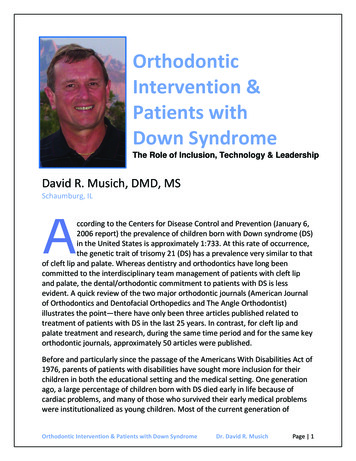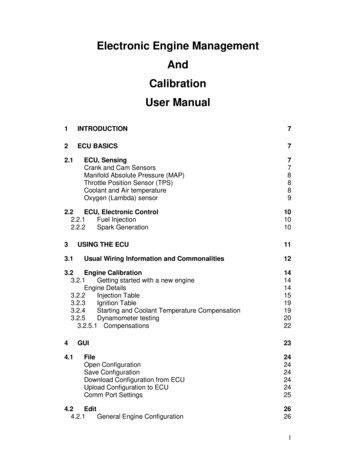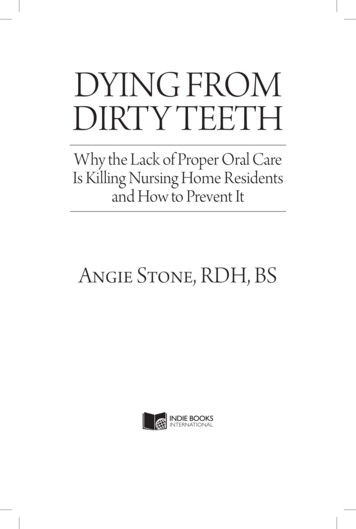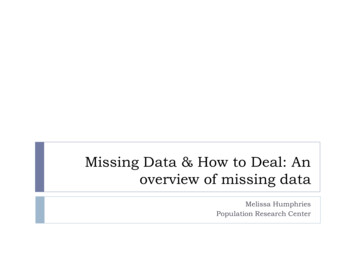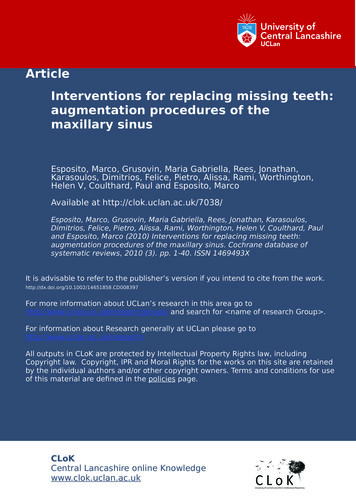
Transcription
ArticleInterventions for replacing missing teeth:augmentation procedures of themaxillary sinusEsposito, Marco, Grusovin, Maria Gabriella, Rees, Jonathan,Karasoulos, Dimitrios, Felice, Pietro, Alissa, Rami, Worthington,Helen V, Coulthard, Paul and Esposito, MarcoAvailable at http://clok.uclan.ac.uk/7038/Esposito, Marco, Grusovin, Maria Gabriella, Rees, Jonathan, Karasoulos,Dimitrios, Felice, Pietro, Alissa, Rami, Worthington, Helen V, Coulthard, Pauland Esposito, Marco (2010) Interventions for replacing missing teeth:augmentation procedures of the maxillary sinus. Cochrane database ofsystematic reviews, 2010 (3). pp. 1-40. ISSN 1469493XIt is advisable to refer to the publisher’s version if you intend to cite from the r more information about UCLan’s research in this area go tohttp://www.uclan.ac.uk/researchgroups/ and search for name of research Group .For information about Research generally at UCLan please go tohttp://www.uclan.ac.uk/research/All outputs in CLoK are protected by Intellectual Property Rights law, includingCopyright law. Copyright, IPR and Moral Rights for the works on this site are retainedby the individual authors and/or other copyright owners. Terms and conditions for useof this material are defined in the policies page.CLoKCentral Lancashire online Knowledgewww.clok.uclan.ac.uk
Interventions for replacing missing teeth: augmentationprocedures of the maxillary sinus (Review)Esposito M, Grusovin MG, Rees J, Karasoulos D, Felice P, Alissa R, Worthington HV,Coulthard PThis is a reprint of a Cochrane review, prepared and maintained by The Cochrane Collaboration and published in The Cochrane Library2010, Issue 4http://www.thecochranelibrary.comInterventions for replacing missing teeth: augmentation procedures of the maxillary sinus (Review)Copyright 2010 The Cochrane Collaboration. Published by John Wiley & Sons, Ltd.
TABLE OF CONTENTSHEADER . . . . . . . . . . . . . . . . . . . .ABSTRACT . . . . . . . . . . . . . . . . . . .PLAIN LANGUAGE SUMMARY . . . . . . . . . . .SUMMARY OF FINDINGS FOR THE MAIN COMPARISONBACKGROUND . . . . . . . . . . . . . . . . .OBJECTIVES . . . . . . . . . . . . . . . . . .METHODS . . . . . . . . . . . . . . . . . . .RESULTS . . . . . . . . . . . . . . . . . . . .Figure 1. . . . . . . . . . . . . . . . . .DISCUSSION . . . . . . . . . . . . . . . . . .AUTHORS’ CONCLUSIONS . . . . . . . . . . . .ACKNOWLEDGEMENTS. . . . . . . . . . . . .REFERENCES . . . . . . . . . . . . . . . . . .CHARACTERISTICS OF STUDIES . . . . . . . . . .Interventions for replacing missing teeth: augmentation procedures of the maxillary sinus (Review)Copyright 2010 The Cochrane Collaboration. Published by John Wiley & Sons, Ltd.11225669161617181822i
[Intervention Review]Interventions for replacing missing teeth: augmentationprocedures of the maxillary sinusMarco Esposito1 , Maria Gabriella Grusovin1 , Jonathan Rees1 , Dimitrios Karasoulos1 , Pietro Felice2 , Rami Alissa1 , Helen V Worthington3 , Paul Coulthard11 Departmentof Oral and Maxillofacial Surgery, School of Dentistry, The University of Manchester, Manchester, UK. 2 Department ofOral and Dental Sciences, University of Bologna, Bologna, Italy. 3 Cochrane Oral Health Group, School of Dentistry, The Universityof Manchester, Manchester, UKContact address: Marco Esposito, Department of Oral and Maxillofacial Surgery, School of Dentistry, The University of Manchester,Higher Cambridge Street, Manchester, M15 6FH, UK. espositomarco@hotmail.com. marco.esposito@manchester.ac.uk.Editorial group: Cochrane Oral Health Group.Publication status and date: Edited (no change to conclusions), published in Issue 4, 2010.Review content assessed as up-to-date: 6 January 2010.Citation: Esposito M, Grusovin MG, Rees J, Karasoulos D, Felice P, Alissa R, Worthington HV, Coulthard P. Interventions forreplacing missing teeth: augmentation procedures of the maxillary sinus. Cochrane Database of Systematic Reviews 2010, Issue 3. Art.No.: CD008397. DOI: 10.1002/14651858.CD008397.Copyright 2010 The Cochrane Collaboration. Published by John Wiley & Sons, Ltd.ABSTRACTBackgroundInsufficient bone volume is a common problem encountered in the rehabilitation of the edentulous posterior maxillae with implantsupported prostheses. Bone volume is limited by the presence of the maxillary sinus together with loss of alveolar bone height. Sinus liftprocedures increase bone volume by augmenting the sinus cavity with autogenous bone and/or commercially available biomaterials.ObjectivesTo determine whether and when augmentation of the maxillary sinus are necessary and which are the most effective augmentationtechniques for rehabilitating patients with implant-supported prostheses.Search methodsThe Cochrane Oral Health Group’s Trials Register, CENTRAL, MEDLINE and EMBASE were searched on 7th January 2010. Severaldental journals were handsearched. The bibliographies of review articles were checked, and personal references were searched. Morethan 55 implant manufacturing companies were also contacted.Selection criteriaRandomised controlled trials (RCTs) of different techniques and materials for augmenting the maxillary sinus for rehabilitation withdental implants reporting the outcome of implant success/failure at least to abutment connection.Data collection and analysisScreening of eligible studies, assessment of the methodological quality of the trials and data extraction were conducted independentlyand in duplicate. Authors were contacted for any missing information. Results were expressed as random-effects models using meandifferences for continuous outcomes and odds ratios for dichotomous outcomes with 95% confidence intervals. The statistical unit ofthe analysis was the patient.Interventions for replacing missing teeth: augmentation procedures of the maxillary sinus (Review)Copyright 2010 The Cochrane Collaboration. Published by John Wiley & Sons, Ltd.1
Main resultsTen RCTs out of 29 met the inclusion criteria. One trial of 15 patients evaluated implants 5 mm long with 6 mm diameter as analternative to sinus lift in bone with a residual height of 4 to 6 mm. Nine trials with 235 patients compared different sinus lift techniques;of these four trials (114 patients) evaluated the efficacy of platelet-rich plasma (PRP). Due to the variety of techniques evaluated, metaanalysis was only possible of use of PRP for implant failure (two trials) and complications (three trials). No statistically significantdifference was observed.Authors’ conclusionsConclusions are based on few small trials, with short follow-up, and judged to be at high risk of bias. Therefore conclusions should beviewed as preliminary and interpreted with great caution. It is still unclear when sinus lift procedures are needed. 5 mm short implantscan be successfully loaded in maxillary bone with a residual height of 4 to 6 mm but their long-term prognosis is unknown. Elevatingthe sinus lining in presence of 1 to 5 mm of residual bone height without the addition of a bone graft may be sufficient to regeneratenew bone to allow rehabilitation with implant-supported prostheses. Bone substitutes might be successfully used as replacements forautogenous bone. If the residual alveolar bone height is 3 to 6 mm a crestal approach to lift the sinus lining, to place 8 mm implantsmay lead to fewer complications than a lateral window approach, to place implants at least 10 mm long. There is no evidence that PRPtreatment improves the clinical outcome of sinus lift procedures with autogenous bone or bone substitutes.PLAIN LANGUAGE SUMMARYInterventions for replacing missing teeth: augmentation procedures of the maxillary sinusSufficient bone quantity is required for dental implant placement. Bone quantity towards the back of the upper jaw may be insufficientfor dental implant placement because of the presence of the maxillary sinus, a natural cavity within the bone. This cavity may enlargefollowing tooth loss. There are a number of techniques, termed sinus lift procedures, aimed at increasing bone quantity prior to implantplacement. These techniques utilise bone graft material, either the patients own bone (autogenous bone), a range of commerciallyavailable materials (biomaterials) or a combination of the two.Short implants (5 to 8 mm) may be as effective and cause fewer complications than longer implants placed using a more complextechnique. It is not clear that bone graft materials are needed or whether some bone graft materials are more effective than others.Biomaterials might be used in place of autogenous bone. There is no evidence to suggest factors extracted from the patients bloodimprove bone healing.Interventions for replacing missing teeth: augmentation procedures of the maxillary sinus (Review)Copyright 2010 The Cochrane Collaboration. Published by John Wiley & Sons, Ltd.2
Interventions for replacing missing teeth: augmentation procedures of the maxillary sinus (Review)Copyright 2010 The Cochrane Collaboration. Published by John Wiley & Sons, Ltd.3200 per 1000High risk population100 per 1000Medium risk population50 per 1000122 per 1000(18 to 854)61 per 1000(9 to 427)31 per 1000(5 to 213)PRPno PRPLow risk populationaCorresponding riskAssumed riskIllustrative comparative risks* (95% CI)OR 0.61 (0.09 to 4.27)Relative effect(95% CI)91(2)No of participants(studies) OOlowbQuality of the evidence(GRADE)CommentsCI: Confidence interval; OR: Odds ratio.*The basis for the assumed risk (e.g. the median control group risk across studies) is provided in footnotes. The corresponding risk (and its 95% confidence interval) is based on theassumed risk in the comparison group and the relative effect of the intervention (and its 95% CI).Implant failure(at 0 to 2 years)OutcomesPatient or population: patients with insufficient bone below maxillary sinusSettings: dental practiceIntervention: PRPComparison: no PRPGraft with PRP compared with graft without PRP for sinus lift proceduresS U M M A R Y O F F I N D I N G S F O R T H E M A I N C O M P A R I S O N [Explanation]
Interventions for replacing missing teeth: augmentation procedures of the maxillary sinus (Review)Copyright 2010 The Cochrane Collaboration. Published by John Wiley & Sons, Ltd.4Population is defined as patients who require dental implants.Poor study design for both (split-mouth and parallel xxxxxxxxxxxxxxxxxxxxxxxxxxxxxxxxxbaGRADE Working Group grades of evidenceHigh quality: Further research is very unlikely to change our confidence in the estimate of effect.Moderate quality: Further research is likely to have an important impact on our confidence in the estimate of effect and may change the estimate.Low quality: Further research is very likely to have an important impact on our confidence in the estimate of effect and is likely to change the estimate.Very low quality: We are very uncertain about the estimate.
BACKGROUNDMissing teeth may result in a functional and cosmetic deficit andhave traditionally been replaced with dentures or bridges. Dentalimplants offer an alternative, they are inserted into the jawbonesand used to support dental prostheses. Dental implants rely onthe maintenance of a direct structural and functional connectionbetween living bone and the implant surface, this is termed osseointegration and was first described by Brånemark (Brånemark1977). Osseointegration has undoubtedly been one of the mostsignificant scientific breakthroughs in dentistry over the past 40years.Insufficient bone volume is a common problem encountered in therehabilitation of the edentulous posterior maxilla with implantsupported prostheses. The bone available for implant placementmay be limited by the presence of the maxillary sinus togetherwith loss of alveolar bone height. Bone volume may be increasedby augmentation, commonly the sinus cavity is augmented withautogenous bone or biomaterials or both. Procedures are variouslydescribed in the literature as sinus lift, sinus augmentation, sinusfloor elevation or augmentation of atrophic maxillary sinus.Implant placement may be combined with sinus augmentation asa ’one-stage’ technique. Alternatively sinus augmentation may becarried out at some time prior to implant placement, as a ’twostage’ technique which requires an additional surgical episode.(Summers 1994). For cases of less than 6 mm residual bone height,Summers proposed a two-stage approach. A bone plug is definedwith a trephine and displaced superiorly with the use of a broadosteotome. Hydrostatic pressure elevates the mucosal lining of thesinus. The resultant osteotomy is filled with a bone graft materialand the implant placed after a period of healing (Summers 1995).Cosci modified the crestal approach technique utilising an atraumatic lifting drill to reduce the risk of perforation of the mucosalining the sinus using this one-stage technique with as little as 3mm of residual bone (Cosci 2000). Bone can be collected with atrephine directly from the osteotomy site to be used as graftingmaterial, a bone substitute can be used or the implant tip can holdup the sinus membrane that will work as a natural barrier for boneregeneration. While the crestal approach is less invasive and is aone-stage technique, there are some disadvantages associated withit. The amount of bone which can be gained using a crestal approach is usually less than that obtained with the lateral windowtechnique, and a minimum of 3 mm crestal bone height is generally recommended to stabilize the implant at placement (Cosci2000).In order to obtain simultaneous vertical bone augmentation witha sinus lift procedure, Cannizzaro proposed a technique that is acombination of a sinus lift and an onlay graft. Implants are placedin the ulna, bone blocks containing the implants are retrieved witha trephine, inserted into the sinus via a crestal approach and leftprotruding occlusally for some mm in order to obtain simultaneous vertical bone gain (Cannizzaro 2007).Techniques of sinus augmentation (sinus lift)Boyne described the pre-prosthetic surgical technique of retrograde sinus augmentation, in some cases blade implants wereplaced (Boyne 1980). The technique required a window to be prepared in the lateral wall of the sinus via a buccal sulcus incision,the mucosal lining was elevated to create a cavity into which particulate bone from the iliac crest was placed and allowed to healfor about 6 months or more before placing the implants.Tatum described five tissue incisions (crestal, palatal, split thickness palatal, vertical and horizontal vestibular), three types of boneaccess (crestal, buccal wall and Le Forte I), the use of autogenousbone, allograft and alloplast. In addition Tatum described sinusaugmentation and implant placement as a one-stage and a twostage technique (Tatum 1986).The technique, known as a lateral window sinus lift, is widelyused today and is considered reliable particularly when autogenousbone is used (Wallace 2003; Del Fabbro 2004).Summers described a less invasive one-stage technique for sinusfloor elevation with simultaneous implant placement called theosteotome sinus floor elevation. Summers considered necessary atleast 6 mm of residual bone to ensure primary stability of the implant. Concave tipped osteotomes of increasing diameter appliedvia a crestal approach advanced a mass of bone beyond the levelof the original sinus floor, elevating the mucosal lining. Summerscombined this procedure with the addition of a bone graft materialMaterials used in sinus lift proceduresAutogenous bone has long been considered the gold standard(Palmer 2000). Intra-oral donor sites (chin and ramus) are convenient but yield limited volume. Extra-oral donor sites (iliac crest,tibia, ulna, rib and calvarium) increase surgical complexity andare associated with significant (and underreported) morbidity andscarring. Therefore alternative grafting materials (bone substitutes)have been developed.Allografts consist of ’same species’ tissue. Cadaveric bone is harvested and various techniques (freeze drying and irradiation) reduce antigenicity. The grafts are then sterilised and supplied byspecially licensed tissue banks.Xenografts consist of ’different species’ tissue. Anorganic bovineand equine bone predominate. Chemical removal of the organiccomponent creates a mineral scaffold.Alloplasts are synthetic bone substitutes. There are many typesclassified in terms of porosity as dense, macro-porous, microporous, and either crystalline or amorphous. The structure influences performance. Some examples are: beta tri-calcium phosphate, bio-active glass, calcium sulphate.All these graft materials can be delivered in various convenientforms such as bone particles or large blocks, can be mixed withInterventions for replacing missing teeth: augmentation procedures of the maxillary sinus (Review)Copyright 2010 The Cochrane Collaboration. Published by John Wiley & Sons, Ltd.5
autogenous bone and can be very stable over time or highly resorbable, depending on their chemical characteristics.Urist discovered that cell free, decalcified bone implanted into extra-skeletal sites stimulated new bone formation (Urist 1965). Thebiologically active molecules responsible belong to the growth factor B family and are called bone morphogenetic proteins (BMPs)(Valentin-Opran 2002). A number have been discovered (growthfactors, platelet-rich plasma (PRP), and other molecules) and theiruse requires a delivery system that mimics the physical propertiesand release kinetics of bone.Some authors have proposed sinus augmentation without the useof a graft material, coagulated blood acting as a scaffold for boneformation. Lundgren proposed maintaining a space by suturingthe sinus lining to the lateral wall (Lundgren 2004). The implantapex may be used to support the sinus membrane (Nedir 2006;Hatano 2007; Thor 2007; Sohn 2008; Gabbert 2009; Pjetursson2009). Some bone regeneration does occur as a result of this procedure though the actual clinical benefit remains in doubt sincethis method has not been evaluated against appropriate controlprocedures.shorter implants may have a poorer prognosis than longer ones.Since it is commonly believed that shorter implants (8 mm orless) have a poorer prognosis than longer implants, clinicians placelonger implants if bone allows. When bone height is 5 to 8 mmclinicians must decide whether to augment or place short implants.It is possible that in the future new and improved implant surfacemodifications and designs, together with improved surgical techniques may shift the balance in favour of short implants, whenthe alternative is a more complex augmentation procedure. Noreliable evidence of the superiority of currently available surfacemodifications or designs has been documented so far (Esposito2007).Several ’systematic’ reviews have been published on the outcomeof sinus lifting procedures (Tong 1998; Wallace 2003; Del Fabbro2004; Emmerich 2005; Aghaloo 2007; Pjetursson 2008; Tan2008; Nkenke 2009), however, since those findings were not basedon the most reliable clinical studies, a systematic review basedon the most reliable evidence would be useful to summarise thecurrent scientific knowledge.Alternative techniques to sinus liftOBJECTIVESThere are some alternative techniques to sinus augmentation,which may be possible. Onlay bone grafts may be used for horizontal or vertical augmentation. These procedures are evaluatedin another Cochrane systematic review (Esposito 2009).Implants can also be placed with an angulated direction in orderto avoid the maxillary sinus (Aparicio 2001). These implants arecalled ’tilted’ or ’angulated’ implants and they can only be usedwhen anatomical conditions permit.Zygomatic implants offer an alternative to sinus augmentation.Long implants pass through the sinus (Brånemark 2004) or laterally to the sinus into the zygomatic process. Zygomatic implantsare evaluated in another Cochrane review (Esposito 2005). In somesituations angled implants may be placed into the pterygomaxilla(Graves 1994).Another alternative to sinus lift procedures is the use of shortimplants. Current research is focused on evaluating short implantsplaced without augmentation, offering the opportunity of a lesscomplex, cheaper and faster alternative to augmentation. There arefew comparative studies evaluating the efficacy of short implants(Esposito 2009). There is some variation as to the definition ofshort implants. Implants with lengths of 5 to 8 mm are currentlyused, and may be defined as short implants (Renouard 2006),though this is controversial as some authors consider implants of7 to 10 mm to be short (das Neves 2006).A review of longitudinal studies suggested a failure rate of approximately 10% for implants 7 mm long (das Neves 2006). Howeverthe design of the studies on which this estimate is based suggestthat this figure should be viewed with caution as it may representa gross underestimation. Nevertheless these figures suggest thatGeneral objectivesTo test the null hypothesis that there is no difference in the outcomes of implant success, function, complication rate and patientsatisfaction as a result of bone augmentation, compared to no augmentation. Furthermore there is no difference between differentmaxillary sinus lift techniques for dental implant treatment withregard to these outcomes.Specific objectives(A) To test whether and when sinus lift procedures are necessary.(B) To test which is the most effective augmentation technique forsinus lift.METHODSCriteria for considering studies for this reviewTypes of studiesRandomised controlled clinical trials (RCTs) including splitmouth studies.Interventions for replacing missing teeth: augmentation procedures of the maxillary sinus (Review)Copyright 2010 The Cochrane Collaboration. Published by John Wiley & Sons, Ltd.6
Types of participantsPatients with missing teeth and an atrophic posterior maxilla whomay require augmentation of the maxillary sinus prior to or atplacement of dental implants.Types of interventionsAny bone augmentation technique, active agent (such as bonemorphogenetic proteins, platelet-rich plasma) or biomaterials usedtogether with osseointegrated, root-formed dental implants. Fortrials to be considered in this review, implants have to be placedand the success/failure of the implant therapy has to be reportedat least at the endpoint of the abutment connection procedure.The following time points were considered: abutment connection,prosthetic loading, up to 1 year, 3 and 5 years after loading.Types of outcome measuresOutcome measures included. Prosthesis failure: planned prosthesis which could not beplaced due to implant failure(s) and loss of the prosthesissecondary to implant failure(s). Implant failure: implant mobility and removal of stableimplants dictated by progressive marginal bone loss or infection(biological failures). Biological failures were grouped as early(failure to establish osseointegration) and late failures (failure tomaintain the established osseointegration). Failures that occurredbefore prosthesis placement were considered early failures.Implant mobility could be assessed manually or with instrumentssuch as Periotest (Siemens AG, Benshein, Germany) or resonancefrequency (Osstell, Integration Diagnostics, Göteborg, Sweden). Augmentation procedure failure: failure of theaugmentation procedure not affecting the success of the implant. Major complications at treated sites (e.g. sinusitis,infection, haemorrhage, etc.). Major complications at bone donor sites (e.g. nerve injury,gait disturbance, infection, etc.). Patient satisfaction. Patient preference (only in split-mouth trials). Bone gain expressed in mm or percentage. Duration of the treatment time starting from the firstintervention to the functional loading of the implants. Treatment costs.Trials evaluating only histological outcomes were not consideredin this review.Search methods for identification of studiesFor the identification of studies included or considered for thisreview, detailed search strategies were developed for each databasesearched. These were based on the search strategy developed forMEDLINE (OVID) but revised appropriately for each database.The search strategy used a combination of controlled vocabularyand free text terms and was run with the Cochrane Highly SensitiveSearch Strategy (CHSSS) for identifying randomised trials (RCTs)in MEDLINE: sensitivity maximising version (2009 revision) asreferenced in Chapter 6.4.11.1 and detailed in box 6.4.c of theCochrane Handbook for Systematic Reviews of Interventions Version5.0.2 (updated September 2009) (Higgins 2009). Details of theMEDLINE search are provided in Appendix 1.Searched databases The Cochrane Oral Health Group’s Trials Register (to 7thJanuary 2010), seeAppendix 2. The Cochrane Central Register of Controlled Trials(CENTRAL) (The Cochrane Library 2009, Issue 4), seeAppendix3. MEDLINE via OVID (1950 to 7th January 2010),seeAppendix 1. EMBASE via OVID (1980 to 7th January 2010),seeAppendix 4.The most recent electronic search was undertaken on 7th January2010.LanguageThere were no language restrictions.Unpublished studiesWe wrote to all the authors of the identified RCTs, we checkedthe bibliographies of all identified RCTs and relevant review articles, and we used personal contacts in an attempt to identifyunpublished or ongoing RCTs. In the first version of this reviewwe also wrote to more than 55 oral implant manufacturers andwe requested information on trials through an Internet discussiongroup (implantology@yahoogroups.com), however we discontinued this due to poor yield.HandsearchingDetails of the journals being handsearched by the Cochrane OralHealth Group’s ongoing programme are given on the website:http://www.ohg.cochrane.org/.The following journals have been identified as being potentiallyimportant to be handsearched for this review: British Journal ofOral and Maxillofacial Surgery, Clinical Implant Dentistry and Related Research, Clinical Oral Implants Research, European Journal ofOral Implantology, Implant Dentistry, International Journal of Oraland Maxillofacial Implants, International Journal of Oral and Maxillofacial Surgery, International Journal of Periodontics and Restorative Dentistry, International Journal of Prosthodontics, Journal ofClinical Periodontology, Journal of Dental Research, Journal of OralImplantology, Journal of Oral and Maxillofacial Surgery, JournalInterventions for replacing missing teeth: augmentation procedures of the maxillary sinus (Review)Copyright 2010 The Cochrane Collaboration. Published by John Wiley & Sons, Ltd.7
of Periodontology, and Journal of Prosthetic Dentistry. Where thesehave not already been searched as part of the Cochrane JournalHandsearching Programme, the journals were handsearched byone review author up to the month in which the last electronicsearch was undertaken.Data collection and analysisStudy selectionThe titles and abstracts (when available) of all reports identifiedthrough the electronic searches were scanned independently bytwo review authors. For studies appearing to meet the inclusioncriteria, or for which there were insufficient data in the title andabstract to make a clear decision, the full report was obtained. Thefull reports obtained from all the electronic and other methodsof searching were assessed independently by two review authorsto establish whether the studies met the inclusion criteria or not.Disagreements were resolved by discussion. Where resolution wasnot possible, a third review author was consulted. All studies meeting the inclusion criteria then underwent validity assessment anddata extraction. Studies rejected at this or subsequent stages wererecorded in the table of excluded studies, and reasons for exclusionrecorded.Data extractionData were extracted independently by two review authors usingspecially designed data extraction forms. The data extraction formswere piloted on several papers and modified as required beforeuse. Any disagreement was discussed and a third review authorconsulted where necessary. All authors were contacted for clarification or missing information. Data were excluded until furtherclarification was available if agreement could not be reached.For each trial the following data were recorded. Year of publication, country of origin and source of studyfunding. Details of the participants including demographiccharacteristics, source of recruitment and criteria for inclusion. Details of the type of intervention. Details of the outcomes reported, including method ofassessment, and time intervals.Risk of bias in included studiesAn assessment of the risk of bias in included studies was undertaken following the recommendations as described in Chapter 8of the Cochrane Handbook for Systematic Reviews of Interventions5.0.2 (Higgins 2009). Two review authors independently and induplicate assessed the risk of bias of all included studies. In thecase that the paper to be assessed had one or more review authorsin the authors list, it was independently evaluated only by thosereview authors not involved in the trials. Any disagreement wasdiscussed and where necessary a third review author was consultedto achieve consensus. Authors were contacted directly for clarification.A specific tool for assessing risk of bias in each included study wasadopted. This comprised a description and a judgement for eachentry in a risk of bias table, where each entry addressed a specificfeature of the study: Adequate
Implant placement may be combined with sinus augmentation as a 'one-stage' technique. Alternatively sinus augmentation may be carried out at some time prior to implant placement, as a 'two-stage' technique which requires an additional surgical episode. Techniques of sinus augmentation (sinus lift)

